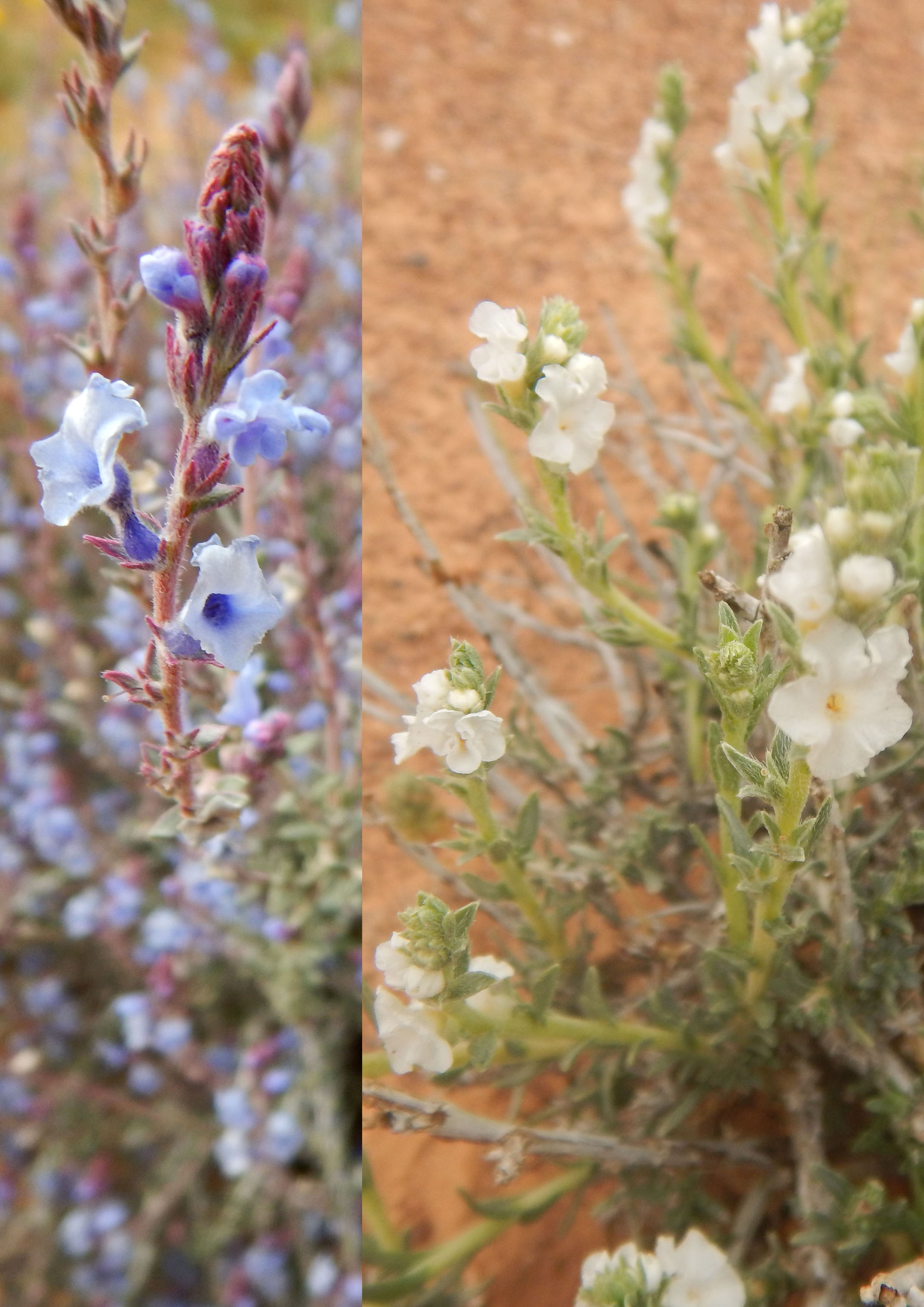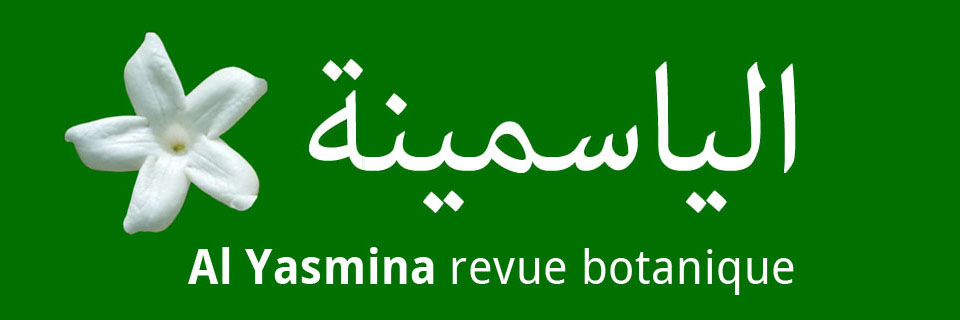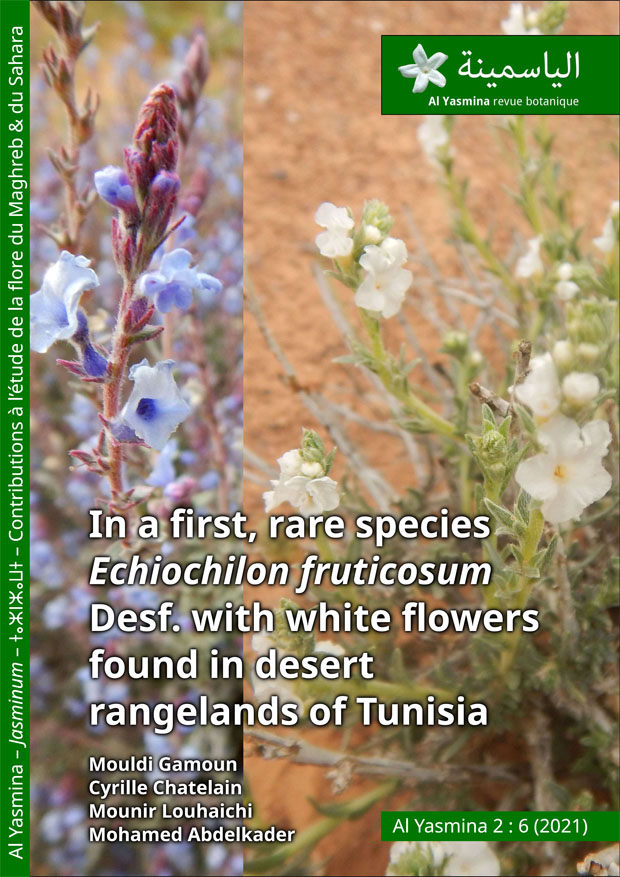

Cyrille Chatelain
Mounir Louhaichi
Mohamed Abdelkader


2 Conservatoire et Jardin botaniques de la Ville de Genève, C.P. 71, 1292 Chambésy, Suisse.
3 Office of Livestock and Pasture (OEP), Ministry of Agriculture, Fisheries, and Water Resources, Tunisia.
* corresponding author : M.Gamoun@cgiar.org

Abstract
Fieldwork, particularly if it is frequently, did provide an opportunity to explore further plant diversity and extending knowledge. In this study, we illustrate the two individuals of Echiochilon fruticosum Desf. that differ from each other by the color of flowers. Echiochilon fruticosum Desf., which is characterized by giving a blue color of flowers, this time was found with impressive white flowers. What’s up with that ? Albinism is not too common but is certainly possible.
Keywords : Corolla color, mutation, albinism
يقدم العمل الميداني، خاصة إذا كان متكررًا، فرصة لإستكشاف المزيد من التنوع النباتي وتوسيع المعرفة. في هذا المقال نقدم فردين من Echiochilon fruticosum يختلفون عن بعضهم البعض من حيث لون الأزهار. في هذا العمل الميداني، تم العثور على Echiochilon fruticosum، و الذي يتميز بأزهار زرقاء اللون، ولكن هذه المرة الأولى بأزهار بيضاء صافية البياض و رائعة. ما الأمر في ذلك؟ المهق الكامل لدى النباتات ليس شائعًا جدًا ولكنه ممكن بالتأكيد.
Résumé
Le travail de terrain, en particulier s'il est fréquent, a permis d'explorer davantage la diversité végétale et d'étendre les connaissances. Dans cette étude, nous illustrons les deux individus d'Echiochilon fruticosum, qui diffèrent les unes des autres par la couleur des fleurs. Echiochilon fruticosum, qui se caractérise par la couleur bleue de ses fleurs, cette fois, a été trouvé avec superbe fleurs blanches. Qu'est-ce qui se passe ? L'albinisme n'est pas trop commun chez les plantes, mais est certainement possible.
Introduction
Echiochilon is a genus that belongs to the Boraginaceae family in the major group of Angiosperms. They include 16 species that grow in arid habitats distributed from Mauritania to India. In Tunisia, just one species of Echiochilon is found, it's Echiochilon fruticosum Desf. This species is native to Morocco, Algeria, Tunisia, Libya, Egypt, Palestine, Jordan, Lebanon, Syria and Saudi Arabia, and widely distributed in the sandy and stony soil (Täckholm, 1974, Lebrun, 1979). Based on material from Tunisia, E. fruticosum Desf. was described for the first time by Desfontaines in his Flora Atlantica. It is a shrubby perennial species growing on sandy or rocky soil, having woody stems and branches, prickly ; subulate leaves, prickly ; flowers sessile, axillary. In the nature, variations in wildflowers' color are always striking to see, and the variation in the same species would be more amazing.
In 2018, rangelands of southern Tunisia are well known for an abundance of spring wildflowers among which E. fruticosum, but with one notable exception where one individual species has attractive white flowers. ‘Natural’ mutations or albinism is uncommon among wildflowers in arid and desert rangelands, but this is not impossible after it was reported during the spring of 2018.

Figure 1. Distribution of Echiochilon fruticosum Desf.
Methodology
The plant grows about 30 cm high, erect, very branchy from the base. Branches are thin, smooth, alternate, unequal, often twisted, covered by short white hairs. Leaves are sessile, linear and scattered. Flowers axillary, solitary, sessile. The calyx is deeply divided into unequal lobes. Corolla blue, hispid externally, 6-8 mm long, with a more or less sinuous tube, throat bare, zygomorphic bilabiate leaf blade. Achene 1.5-2 mm, nipple-shaped, grayish brown, hunchbacked at the base, finely rough.
As a result of frequent and intensive fieldwork along the desert and arid rangelands of southern Tunisia during a project to document the botanical composition and species diversity of Tataouine (Gamoun and Louhaichi 2021), result in the discovery of interesting plants in terms of flower color. The newly found was a shrub of E. fruticosum with white flowers located just beside other shrubs of E. fruticosum with blue flowers, on sandy soil. This plant was the only one that was found after doing a completed survey of the area. The plant is the same, but all the corolla lobes are white. It appears to be albinos that can occur as a result of natural mutation.
Discussion
Flowers are the magnificent and vital organ of plants with their brilliant colors that provide eye-catching attributes for amateurs of plant sciences, botanists and pollinators. For botanists, petal color is a valuable feature for plant identification. For instance, the petal color of Boraginaceae may be purple, pink, yellow, or white, but is predominantly blue. Flower color change or mutation results from the effects of several physical and chemical factors and even interactions between them. Variation in flower color is mainly driven by the production of anthocyanins, as their presence provides colors of petals like blue (Clegg et al., 2000 ; Sullivan and Koski 2021).
Like many other changes occurring in nature that deviate from the usual, the white color is the result of a genetic mutation (Ramkissoon, 2021). Kaul and Koul (2012) found that a rare mutation of the color of Commelina benghalensis L. flowers from blue to white in nature must have been in response to eco-habitat conditions, stress and selection pressures.
Many plant species have a natural mutation that causes flowers' color to become white due to a lack of color pigment, mainly anthocyanins. Hyacinthoides non-scripta is a common bluebell with one white bluebell only occurring in one of every 10,000 flowers (Harbod, 2015).
Soil pH can play an important role in the color of plants (Zhao and Tao, 2015). Acidification of soil can enhance the color of plant leaves by affecting anthocyanin synthesis (Sun et al., 2008), while no effect on flower color (Liu et al. 2011).
In the arid and desert rangelands of Tunisia, as far as we can remember, we've never seen a white E. fruticosum that is normally blue, but abnormal white flowers have been reported in a single species in close proximity to plants with blues flowers. Albinism in plants is characterized by the white color of organs (leaves, stem, flowers) due to partial or complete loss of photosynthetic pigments. Popular literature indicates that albinism in plants is a very rare phenomenon that has been reported in more than 50 plant species (Silva et al., 2020). Maybe also, E. fruticosum has been failed to produce flower pigmentation and as a result, its flowers are becoming abnormally white. The references do not include albinism in E. fruticosum, some research should be conducted, to discover that the flowers were an albino or a new variety of Echiochilon.
Conclusion
An extremely rare Echiochilon fruticosum Desf. with white flowers has been sighted first time in the desert areas in Tataouine in the year 2018. We are delighted to have such gifts bestowed by nature because it seems albinism and the data of albinism in desert plants, especially shrubs, are scarce. Additionalresearch is needed to find answers to other key questions such as, “Is it really an albinism or a new variety of Echiochilon“.
References
Clegg MT., Durbin ML. 2000. Flower color variation : a model for the experimental study of evolution. Proc Natl Acad Sci USA. 97 : 7016-7023. 10.1073/pnas.97.13.7016.
Desfontaines R.L. 1798. Flora Atlantica : sive historia plantarum quae in Atlante, agro tunetano et algeriensi crescunt. Tomus secundus. Paris, Panckoucke.
Gamoun M., Louhaichi M. 2012. Botanical Composition and Species Diversity of Arid and Desert Rangelands in Tataouine, Tunisia. Land, 10, 313. https://doi.org/10.3390/land10030313
Harbod M. 2015. May – the time for carpets of bluebells. Nature blog. http://www.hollingtonwood.com/2015/06/29/may-the-time-for-carpets-of-bluebells/
Kaul V., Koul A.K. 2012. Flower color mutant and its possible significance in Commelina benghalensis L. (Commelinaceae). The Nucleus 55 (2), 89-93.
Lebrun J.P. 1979. Eléments pour un atlas des plantes vasculaires de l'Afrique sèche. Etude botanique de l'I.E.M.V.T. 6, 2, Maison Alfort 255 p. + 48 cartes.
Ramkissoon J. 2021. Bluebonnets that aren’t blue ? How different colors, including white, can pop up in the state flower.
Silva L.A.S., Sampaio V.F., Barbosa L.C.S., Machado M., Flores-Borges D.N.A., Sales J. F., de Oliveira D.C., Mayer J.L.S. , Kuster V.C., Rocha D.I. 2020. Albinism in plants : far beyond the loss of chlorophyll. Structural and physiological aspects of wild‐type and albino royal poinciana (Delonix regia) seedlings. Plant Biology. doi :10.1111/plb.13146
Sullivan CN., Koski MH. 2021. The effects of climate change on floral anthocyanin polymorphisms. Proceedings of the Royal Society B : Biological Sciences. DOI : 10.1098/rspb.2020.2693.
Täckholm V. 1974. Student’s flora of Egypt, 2nd ed. Cairo University Press, Cairo.
Zhao D., Tao J. 2015. Recent advances on the development and regulation of flower color in ornamental plants. Front. Plant Sci. 6 : 261. doi : 10.3389/fpls.2015.00261.